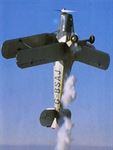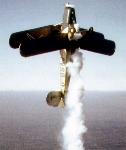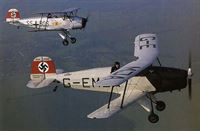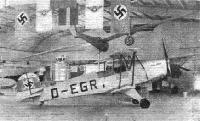
Описание
Страна : Германия
Год : 1934
Двухместный самолет первоначального обучения и легкий ночной бомбардировщик
Bucker Bu 131 Jungmann
Первым серийным изделием фирмы "Bucker Flugzeugbau GmbH", основанной в 1932 году в Йоханништаль, стал легкий двухместный учебный самолет Bucker Bu 131 Jungmann. Самолет спроектирован под руководством главного инженера компании Андерса Андерссона.Он представлял собой типичный биплан, с крыльями небольшой стреловидности. Каркас фюзеляжа изготовлен из стальных труб, обшивка кабины и капот мотора - из легких сплавов, остальная обшивка - полотняная. Силовые элементы крыла изготовлены из клееной древесины и обтянуты полотном. Хвостовое оперение в конструктивном отношении аналогично фюзеляжу. Шасси - неубираемое, трехопорное, с хвостовой опорой. Прототип, оснащенный мотором Hirth НМ 60К мощностью 80 л.с. выполнил первый полет 27 апреля 1934 года.
Первый серийный вариант Bu 131A зарекомендовал себя очень удачной машиной. Самолеты данного типа строились не только для гражданских летных школ Германии, но также интенсивно использовались в Люфтваффе. Учебные бипланы экспортировались в восемь европейских стран. Крупнейшими импортерами стали Венгрия (100 самолетов) и Румыния (150), еще 75 самолетов собрали по лицензии в Швейцарии. Массовое производство по лицензии велось в Японии, где были построены 1037 самолетов Nippon Kokusai Ki-86a, которые поступили на вооружение авиации Императорской Армии под обозначением Type 4 Primary Trainer. За первой армейской серией последовала серия для авиации ВМС, которые получили обозначение Navy Type 2 Trainer Model 11 (или K9W1 Momiji); самолеты строились на заводах "Hitachi" и "Kyushu". Точное количество самолетов, построенных для японских ВМС, точно неизвестно, но примерно - от 217 до 339. Все самолеты японской постройки, получившие у союзников кодовое обозначение "Cypress", оснащались моторами мощностью 110 л.с. В авиации Императорской Армии они обозначались Hitachi (Ha-47) 11, а в ВМС - Hitachi GK4A Hatsukaze 11. Был построен единственный экспериментальный цельнодеревянный Ki-86B, на испытаниях показавший неудовлетворительные летные данные.
Самолет Jungmann использовался в Люфтваффе на протяжении всей Второй мировой войны, хотя и был создан для замены более совершенный Bu 181. Самолеты обоих типов применялись даже на фронте в частях ночных бомбардировщиков и для борьбы с партизанами. Вооруженные одно- и двухкилограммовыми бомбами самолеты использовались для беспокоящих ночных налетов на советские войска. Большое количество самолетов пережило войну, а в Чехословакии компания "Aero" продолжала в 1950-х годах серийно выпускать Jungmann под обозначением С4.
Варианты
Bu 131B Jungmann: улучшенный вариант с двигателем Hirth НМ 504A-2
Bu 131C Jungmann: один опытный образец с мотором Cirrus Minor мощностью 90 л. с. (68 кВт)
ТАКТИКО-ТЕХНИЧЕСКИЕ ХАРАКТЕРИСТИКИ
Bucker Bu 131B Jungmann
Тип: двухместный самолет первоначального обучения и легкий ночной бомбардировщик
Силовая установка: один мотор жидкостного охлаждения с перевернутым блоком цилиндров НМ 504A-2 мощностью 105 л. с. (78 кВт)
Летные характеристики: максимальная скорость на уровне моря 183 км/ч; крейсерская скорость на оптимальной высоте 170 км/ч; время набора высоты 1000м - 6 мин 18с; практический потолок 3000 м; дальность 650 км
Масса: пустого 390 кг; максимальная взлетная 680 кг
Размеры: размах крыла 7,40 м; длина 6,60 м; высота 2,25 м; площадь крыла 13,50 м1
Вооружение: штатно отсутствует, хотя предусмотрена возможность размещения в задней кабине легких осколочных бомб, в процессе эксплуатации на нижнем крыле установлены держатели для легких бомб
Описание:
- Bucker Bu 131 Jungmann
- Kokusai Ki-86
- Flight, November 1934
THE FOURTEENTH PARIS AERO SHOW - Flight, May 1936
A CONTINENTAL TRAINER
Фотографии
-
Авиация и Время 1995-06 / А.Котлобовский - В тени Люфтваффе (Венгерские ВВС. Октябрь 1944 - май 1945г.) /Аэроархив/ (5)
Учебно-тренировочный Bu 131D одной из авиашкол, лето 1941г.
-
Aeroplane Monthly 1996-05 / Bucker Jungmann E3B-114/G-BUCC /Preservation Profile/
Регистрационный номер: G-BUCC [3] The colour plate, by RICHARD PAVER, depicts current owner Rick Roberts flying G-BUCC near Chichester, West Sussex, on October 25, 1995.
-
Aeroplane Monthly 1996-05 / Bucker Jungmann E3B-114/G-BUCC /Preservation Profile/
Регистрационный номер: G-BUCC [3] The aircraft, with all control surfaces installed and fuselage markings applied, around the time of the first engine runs in September 1992. It made its first post-restoration flight the following March.
-
Aeroplane Monthly 1996-05 / Bucker Jungmann E3B-114/G-BUCC /Preservation Profile/
Регистрационный номер: G-BUCC [3] Jungmann G-BUCC taking shape at previous owner Edward McEntee’s Sussex home on May 4, 1992.
-
Aeroplane Monthly 1993-03 / M.Oakey - Grapevine
Регистрационный номер: SE-XOB In Sweden, Orvar Bergvall has completed nearly 50hr of flying in his recently-restored and eyecatchingly Spanish-marked Bucker Bu 131 Jungmann SE-XOB, which he acquired from Holland in 1991. Built by CASA in 1954, it flew for 34 years with the Spanish Air Force.
-
Aeroplane Monthly 1991-01
Регистрационный номер: G-BPDM CASA 1-131 Jungmann G-BPDM, operated in the UK by The Spanish Acquisition (Nobody expects..!). was photographed by GORDON BAIN near Shoreham in mid-1990, with Dougal Mann and Malcolm Blows aboard
-
Air Enthusiast 2006-07 / F.Willemsen - Iberian Classics /History on the wing/
FIO operates no fewer than four two-seater Bucker 131 Jungmann biplanes, as welt as single Bucker 133 Jungmeister (foreground).
Другие самолёты на фотографии: Bucker Bu.133 Jungmeister - Германия - 1935
-
Aeroplane Monthly 2000-04 / 2000 Airshows & Museums Guide
Регистрационный номер: G-BUTA One of three Jungmanns (actually all CASA 1.131Es) at the Real Aeroplane Museum, Breighton, G-BUTA is in Spanish Air Force colours.
-
Air Pictorial 1991-10 / M.Gradidge - Gateway to Aviation
Регистрационный номер: G-JUNG British visitors to Oshkosh are rare, but here CASA 1-131E G-JUNG rests beside its owner's tent near the ultra-light runway, while a Fisher Classic lands over a typical Wisconin barn. The owner is a US resident ex-patriate Briton.
Другие самолёты на фотографии: Fisher (FFP) FP-404 / Classic / Celebrity / Youngster - Канада - 1984
-
Aeroplane Monthly 1999-09 / J.Blackman - Anna's Aerobatic Young Man /Airshow performer/
Регистрационный номер: G-BSAJ [7] Although it was underpowered in its original 80 h.p. form, the Jungmann still flew well; an inverted fuel system was fitted as standard.
-
Aeroplane Monthly 1999-05 / 1999 UK Airshows & Museums Guide
Регистрационный номер: G-BSAJ [7] Anna Walker pulls a neat vertical climb in her Bucker Jungmann, a familiar sight now at airshows around the country.
-
Мировая Авиация 217
Регистрационный номер: G-BSAJ [7] В соревнованиях по воздушной акробатике Анна Уолкер стала участвовать с 1992 года. На Bucker Jungmann она завоевала множество призов, а также принимала участие в авиашоу в Великобритании и за ее пределами.
-
Aeroplane Monthly 1999-09 / J.Blackman - Anna's Aerobatic Young Man /Airshow performer/
Регистрационный номер: G-BSAJ [7] Although Anna greatly enjoyed aerobatic competitions, the power-based British intermediate-level sequences put the Jungmann at a disadvantage, so she turned to display flying.
-
Aeroplane Monthly 1999-09 / J.Blackman - Anna's Aerobatic Young Man /Airshow performer/
Регистрационный номер: G-BSAJ [7] With its 150 h.p. ENMA Tigre G-IV-B, G-BSAJ has an adequate margin of power for aerobatics while retaining the type’s excellent handling qualities.
-
Aeroplane Monthly 1999-09 / J.Blackman - Anna's Aerobatic Young Man /Airshow performer/
Регистрационный номер: G-BSAJ [7] From all angles, the Jungmann is a classic 1930s design. Anna has made only a few subtle concessions which enhance the aircraft’s performance without compromising its external appearance.
-
Aeroplane Monthly 1999-09 / J.Blackman - Anna's Aerobatic Young Man /Airshow performer/
Регистрационный номер: G-BSAJ [7] The happy couple. Anna Walker poses with her first love: Bucker Jungmann G-BSAJ.
-
Aeroplane Monthly 1999-11 / M.Oakey, T.Harmsworth - News
Регистрационный номер: G-BUVN Dutch-based CASA Jungmann G-BUVN in RNethAF marks.
-
Aeroplane Monthly 1984-02
Регистрационный номер: G-BECW Neil Jensen's CASA 1-131E, G-BECW, ex Spanish Air Force licence-built Bucker Jungmann, photographed near its Redhill base last year. After CASA's initial batch of 150 aircraft the company built a further 50 in 1956. A number of Spanish and Swiss-built Jungmanns are current on the British civil register.
-
Aeroplane Monthly 1991-09 / M.Oakey - Grapevine
Регистрационный номер: HB-UUE [2] Bucker Bu 131 Jungmann HB-UUE, the only example of the type still wearing its original Swiss Air Force colours and number, A-15. It served in the air force from May 1938 until 1973, and is now flown for the Swiss Antique Aeroplane Association by Ulrich Wenger.
-
Aeroplane Monthly 2001-02 / E.Gandet - The Time Keepers /Swiss preservation/
Регистрационный номер: HB-UUE [2] Switzerland’s aviation heritage preserved (in this case Bucker Jungmann HB-UUE)
-
Jane's All the World Aircraft 2000 / 0-01 - FOREWORD
Регистрационный номер: SP-FPX Designed in 1933, the Bücker Bü 131 Jungmann has returned to production in Poland as the Historic Aircraft Service T-131PA - by no means the only vintage flying machine to enjoy unexpected resuscitation at the close of the millennium (1999)
-
Aeroplane Monthly 1997-06 / M.Oakey - Vintage news
Регистрационный номер: G-EMJA [2] A tri-national threesome of World War Two trainers took to the skies over Suffolk recently: Stearman PT-17 40-1766 (furthest from the camera), flown by owner and wartime Arnold Training Scheme veteran Ed Boulter with Air UK Fokker F.100 captain Bruce Monk; former Lightning pilot Mark Zipfell flying de Havilland Tiger Moth T7842; and Air UK Fokker F.28 pilot Pete Brand flying Bucker Jungmann G-EMJA.
Другие самолёты на фотографии: De Havilland Tiger Moth / D.H.82 - Великобритания - 1931Stearman PT-13 / PT-17 Kaydet / Model 73 (Boeing-Stearman) - США - 1934
-
Aeroplane Monthly 1999-05 / 1999 UK Airshows & Museums Guide
Регистрационный номер: G-EMJA [2] In the livery worn for the 1936 Olympic Games, Bucker Jungmanns flown by Pete Brand and Chris Beal appear as a team this year with a new formation display for 1999.
-
Flight 1938-01 / Flight Advertisements
Регистрационный номер: D-EBZE The new Bucker JUNGMANN Bu 131 B, fitted with a 100 h. p. Hirth motor, is used in fourteen countries for military training and stunt flying. High performances and excellent flying capabilities are obtained by the favourable power/weight ratio, so that "ab initio" as well as aerobatic training can be carried out on the Jungmann. No additional teaching is necessary on taking over the single seat fighter after graduating from the training machine.
-
Jane's All the World Aircraft 1938 / 03 - All the world's aeroplanes
Регистрационный номер: D-EPJI The Bucker "Jungmann" Two-seat Training Biplane (80 h.p. Hirth HM.60R engine).
-
Flight 1936-05 / Flight
Регистрационный номер: D-EXIR A small span and ailerons on all four planes give the Bucker Jungmann a good aerobatic performance.
-
Flight 1936-05 / Flight
Регистрационный номер: D-EGRY The Bucker Jungmann two-seater trainer, and above it the Rhonsperber sailplane.
Другие самолёты на фотографии: DFS Rhonsperber / Sperber Senior / Sperber Junior - Германия - 1935
-
Flight 1937-01 / Flight Advertisements
Регистрационный номер: D-EMJA -
Jane's All the World Aircraft 1946 / 03 - All the world's aeroplanes
Three Bucker Jungmann Two-seat Training Biplanes (100 h.p. Hirth engines).
-
Flight 1936-05 / Flight Advertisements
Регистрационный номер: D-EFEI, D-EFOI, D-EGSY BUCKER JUNGMANN the ideal aircraft for military training, fully licensed for all aerobatics, 80 h.p. engine only, therefore inexpensive in purchase and running.
-
Flight 1938-02 / Flight
Регистрационный номер: D-EBYI SANTA CLAUS’ WORKSHOP: German Bucker Jungmanns, popular for ab initio and aerobatic training, stood on their noses to save hangar space.
-
Flight 1940-01 / Flight
The view (of a Bucker Jungmann) shows as close a bit of formation flying as we can recall.
-
Мировая Авиация 80
Bu 131 Jungmann легче всего отличить от более позднего Bu 133 Jungmeister по мотору с перевернутым блоком цилиндров.
-
Aeroplane Monthly 1997-03 / ??? - Interned! (2)
A visitor to Basle-Birsfelden, on March 5, 1943, was Bu 131A Jungmann CX+HI, Werknummer 314, from A/B Pilots School 23, Kaufbeuren. With a lost cross-country student, it crossed the Swiss border near Rheinfelden and landed with almost empty tanks. Wearing its school emblem on the nose, it had a yellow rudder. Refuelled, it returned to Germany the next day.
-
Aeroplane Monthly 1997-03 / ??? - Interned! (2)
Smart Bu 131 Jungmann CW+BG, Werknummer 483, landed at Basle-Birsfelden on June 14, 1944, from Twin School A43, Crailsheim. The pilot elected to be interned and his aircraft was flown to Freiburg by a Swiss pilot. The unit crest was a yellow shield with black outline and keys, topped by a silver castle.
-
In Action 1002 / Luftwaffe in Action 2 (2)
An already famous photo of Fighter Group 54's "hack" aircraft, a Bucker Bu 131 Jungmeister basic trainer, shown here being camouflaged by brush, on the Eastern Front, 1941.
-
Air Pictorial 1991-10 / Airshow Review
Locally based Bucker Jungmann in 1930s vintage markings.
-
Aeroplane Monthly 1977-09 / News Spotlight
Регистрационный номер: G-BECX CASA 1.131 Jungmann G-BECX, previously served with the Spanish Air Force as E3B-430. It arrived at Elstree on September 19 last year with four others, and is now the property of Neil Williams. It was photographed recently at Old Warden.
-
Air Pictorial 1992-02
Регистрационный номер: G-BTDT Tim Reed's CASA 1-31 Jungmann G-BTDT arrived from Dunkeswell in Devon.
-
Air Pictorial 1977-06
Регистрационный номер: G-BEDA Jungmann G-BEDA at Booker 17/4/77 after its handsome repaint;
-
Aeroplane Monthly 1982-11 / P.Jarrett - Grapevine
Регистрационный номер: G-BUCK The “Luftwaffe” trainer trio is working up. Left to right, are Jungmeister G-AXIH, Jungmann G-BUCK and Steiglitz G-BAAY
Другие самолёты на фотографии: Bucker Bu.133 Jungmeister - Германия - 1935VL Viima - Финляндия - 1936
-
Aeroplane Monthly 1976-11 / B.Martin - Britain's civil aircraft register
Регистрационный номер: G-BECT, G-BECU, G-BEDC Three of the six CASA 1.131s from Spain, G-BECU, G-BECT and G-BEDC, at Elstree on September 26, 1976. Three others crashed.
-
Jane's All the World Aircraft 1964 / 01 - Aircraft
CASA-1.131E, a licence-built version of the Bucker Bu 131 Jungmann trainer
-
Aeroplane Monthly 1979-05
Casa 1-131E (Bucker Bu 131) of 781 Esquadron, Spanish Air Force, piloted by Capt Torrente. Photographed on June 14, 1978, by "Canario" Azaola.
-
Aeroplane Monthly 1979-01
The Spanish-built Jungmann owned and flown by Neil Jensen, photographed near Redhill by Bill
-
Air-Britain Archive 1985-03
Регистрационный номер: CX-AZZ Uruguayan-registered Jungmanns are not exactly numerous either! Here CX-AZZ apparently takes on fuel by the bucket load at an air display with two Harvards visible in the right rear of the shot.
-
Aeroplane Monthly 1988-01 / M.Oakey - Grapevine
Регистрационный номер: OK-RXE The Czech licence-built Bucker Jungmann below was restored during 1984-86 by a group of enthusiasts at Moravska Trebova near Brno in Czechoslovakia. Powered by a Walter Minor 4-III, red, white and blue OK-RXE is a regular airshow performer.
-
Jane's All the World Aircraft 1938 / 03 - All the world's aeroplanes
Регистрационный номер: OK-TAB The Tatra T.131 Two-seat Training Biplane (90 h.p. Tatra engine).
-
Air Pictorial 1957-03 / Air Pictorial's photo-review
Регистрационный номер: HB-OSE Swiss Dornier-built Bucker Bu 131B (c/n. 7) two-seater of the Aero-Club Suisse. Note Swiss national markings on rudders.
-
Flight 1937-09 / Flight
MODERN AIRPORT: A view of the terminal building - reminiscent in general appearance of that at the unlucky Gatwick - of the new Budapest Airport taken on the day before the official opening, with M. Budaor's Bucker Jungmann in the foreground. The building must be one of the most beautifully arranged and decorated at any airport in the world.
-
Мировая Авиация 166
Kokusai Ki-86, аналог Bucker Bu 131, эксплуатировался с 1944 года в качестве стандартного самолета первоначального обучения.
Kokusai Type 4 Primary Trainer (Ki.86 "Cypress"). -
Авиация и Время 2012-04 / А.Котлобовский, И.Сеидов - Затупившиеся мечи самураев (4)
Камикадзе иногда использовали учебные самолеты Ки-86
-
Авиация и Время 1995-06 / А.Котлобовский - В тени Люфтваффе (Венгерские ВВС. Октябрь 1944 - май 1945г.) /Аэроархив/ (5)
Связные Bu-131 садились прямо на улицы осажденного Будапешта. Январь 1945г.
-
Jane's All the World Aircraft 1974 / 01 - Aircraft
Регистрационный номер: HB-UUI Bucker Bu 131A refitted by Ateliers de Precision Morand with a 150 hp Lycoming IO-320-E2A engine
-
Jane's All the World Aircraft 1976 / 01 - Aircraft
Four Bucker Bu 131A Jungmann biplanes fitted by Morand with 150 hp Lycoming engines
-
Jane's All the World Aircraft 1966 / 02 - Aircraft
Регистрационный номер: HB-UTD Bucker Bu 131 re-engined with a 180 hp Lycoming engine by the FFA
-
Jane's All the World Aircraft 1964 / 01 - Aircraft
Bucker Bu 131 re-engined with a 170 hp Lycoming engine by the FFA
-
Aeroplane Monthly 1983-05
Регистрационный номер: N707S Mira Slovak's Avia-built Bucker Jungmann, N707S, flying in the USA in the Seventies.
-
Flight 1937-08 / Flight
In the foreground of this general view are the Bucker and Klemm exhibits. The Fokker C11W seaplane is in the distance.
Другие самолёты на фотографии: Fokker C.XI-W - Нидерланды - 1935Klemm Kl.35 / Kl.106 - Германия - 1935
-
Flight 1940-01 / Flight
An exhilarating aerobatic impression secured from the back cockpit of a Bucker Jungmann two-seater trainer of the type which is so popular in Germany.
-
Aeroplane Monthly 1978-01 / Personal album
This CASA 1.131 (licence-built Bucker Bu 131) ended up like this when its pilot attempted a half-loop with insufficient height.
- Фотографии





























































